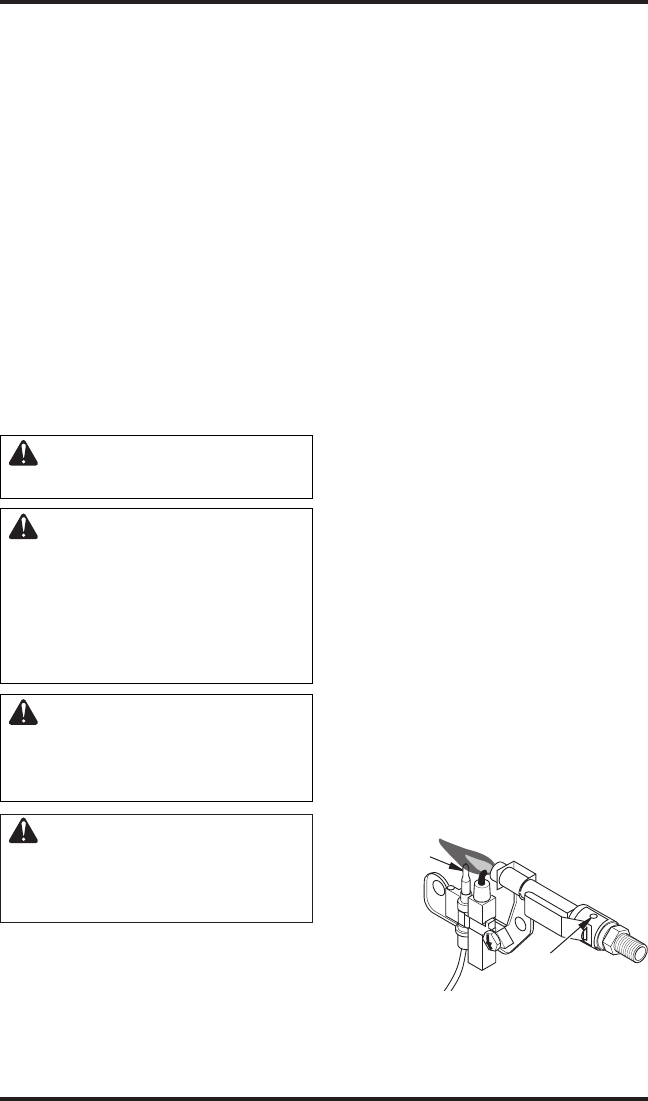
www.desatech.com
113997-01B
8
IMPORTANT: When not in use, the gas must be
turned off at the propane/LP gas supply cylinder.
When the propane/LP gas supply cylinder is not
disconnected from the heater, the heater and the
cylinder must be stored outdoors, in a well ven
-
tilated space, out of reach of children, and must
not be stored in a building, garage or any other
enclosed area.
IMPORTANT: Indoor storage of the heater is
permissible only if the cylinder is disconnected
and removed from the heater. Cylinders must be
stored outdoors out of the reach of children and
must not be stored in a building, garage or any
other enclosed area.
CLEANING AND
MAINTENANCE
WARNING: Turn off heater
and let cool before cleaning.
CAUTION: You must keep
control areas, burner, and circu-
lating air passageways of heater
clean. Inspect these areas of
heater before each use. Have
heater inspected yearly by a
qualified service person.
CAUTION: You must check
and keep burner/venturi tubes
clean of insect and insect nest. A
clogged tube can lead to a fire.
WARNING: Failure to keep
the primary air opening(s) of
the burner(s) clean may result in
sooting and property damage.
ODS/PILOT AND BURNER
Use a vacuum cleaner, pressurized air, or small,
soft bristled brush to clean.
LIGHTING AND OPERATING
INSTRUCTIONS
Continued
BURNER PILOT AIR INLET
The primary air inlet holes allow the proper
amount of air to mix with the gas. This provides a
clean burning flame. Keep these holes clear of dust,
dirt, and lint. Clean these air inlet holes prior to
each heating season. Blocked air holes will create
soot. We recommend that you clean the unit every
three months during operation and have heater
inspected yearly by a qualified service person.
We also recommend that you keep the burner
tube and pilot assembly clean and free of dust and
dirt. To clean these parts we recommend using
compressed air no greater than 30 PSI. Your local
computer store, hardware store, or home center
may carry compressed air in a can. You can use a
vacuum cleaner in the blow position. If using com
-
pressed air in a can, please follow the directions on
the can. If you don't follow directions on the can,
you could damage the pilot assembly.
Always keep the heater area clear and free from
combustible materials, gasoline and other flam
-
mable vapors and liquids.
Keep the vent areas (slots in the bottom and the top
at the front of heater) clear at all times.
Visually inspect the pilot flame and burner periodi
-
cally during use. The pilot flame should be blue
in color (not yellow) and will extend beyond the
thermocouple. The flame will surround the ther-
mocouple just below the tip. See Figure 4. A slight
yellow flame may occur where the pilot flame
and main burner flame meet. The burner should
be bright orange (with a slight blue color around
the border, a red-orange haze that is visible on the
ceramic tile is acceptable) and without a noticeable
flame. A blue flame that rolls out at the top of the
ceramic tile indicates an accumulation of dust, lint
or spider webs inside the casing assembly and main
burner assembly. If the pilot is yellow or the burner
has a noticeable flame, cleaning may be required.
Use the following procedure to inspect the casing
assembly and main burner assembly.
Figure 4 - Pilot
Thermocouple
Air Inlet
Hole


















